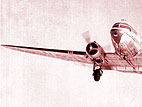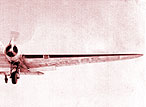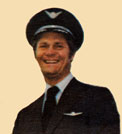 |
 |

I'm reminded of the story of Bill Buhr and our flight one summer's morning back in 1961 between two southern Minnesota towns. North Central Airlines used the venerable Douglas DC-3 to serve this route. It was a quiet Sunday mid-morning when Bill and I departed Fairmont for Worthington, an easy hop of fifty-one miles. After leaving Minneapolis-St. Paul earlier, we had already completed the short hop to Mankato and the even shorter one to Fairmont. A direct line between these next two towns would take us westward along a course aligned with the ubiquitous midwest section lines. It also followed the earth-moving activities associated with construction of the new highway I-90. The next stop, Worthington, claimed to be the "Turkey Capital of the World". It insisted that more turkeys were raised near this town and surrounding communities than anywhere else. A day in the fall of each year was set aside to be celebrated as "Turkey Day". A town or two in Texas or Virginia might want to take exception with this statement, or challenge this claim to fame. I really don't want to take sides in this on-going argument. Unlike many situations, the truth or the statistics (an oxymoron anyway) really aren't germane in the telling of this story. Suffice it to say, there were a lot of turkeys raised in the country surrounding this town.
Anyway, it was my leg to fly. Sometimes we swapped segments, alternating between pilots, and other times we swapped seats for the entire series of legs. This latter option was only done after the co-pilot's successful completion of a check ride given when nearing the end of his first year's probation. This check ride included training in the left seat and, after that, it was left strictly to the captain's discretion. Bill was one of our more easy-to-please types. The co-pilots always looked forward to trips with him. Accordingly, he and I had spent a lot of time together in the cockpit since I had been able to bid and return from Chicago-Midway to the pilot base in Minneapolis the preceding year. With the seat choice being the captain's, he might do either depending upon his mood-of-the-day. On this day, Bill probably thought it was easier to just swap legs, so - my turn.
After departing to the northwest and turning left on course, I contemplated a short climb. We never cruised very high in those unpressurized DC-3s because of the concern for the passenger's (and our) ears. This flight was no exception and, considering the smoothness of the mid-morning air, was probably flown at a modest altitude of a thousand feet or so above the endless corn and oat fields of southern Minnesota. From this vantage point, the visibility was only limited by our inability to see over the horizon. If it hadn't been for this impediment, we probably could have seen all the way to South Dakota. Paperwork and radio chatter hadn't yet intruded greatly into those simple days before all airline flights were required to operate according to the robot like preciseness of a ground managed instrument flight plan. Avoidance of other airplanes was solely our responsibility and the simple economics of a hundred gallon per hour fuel consumption dictated the most direct course between airports. The mid-summer sun's rays streaming through the window into his side of the cockpit and the routineness of the flight soon overwhelmed Bill. Presently I noticed through a sideways glance that his head was resting lightly against the DC-3's side window and his body was relaxed, deriving whatever small amount of comfort was possible in this contorted posture. Probably, I assumed, this quintessential bachelor airline captain had been up fairly late the night before. Had it been the much quieter cockpit of a jet, experienced much later in our aviation careers, I probably could have heard his rhythmic snoring. I, in turn, was left "standing watch" at a leisurely cruising airspeed of 145 knots - a plodding pace by today's standards. After leveling off, I retarded the throttles and propellers to the droning cruise settings on both twelve hundred horsepower Wrights. Thinking life couldn't get much better (until I was promoted to captain) I wiggled around in the seat to achieve my own modicum of comfort in the ancient leather seat (armrests only on the outboard side of either seat). Finally, I closed the cowl flaps, then slowly moved the mixture controls - one at a time - to cruise.
Plenty of time existed to contemplate the endless sea of green farm crops, slowly receding beneath our airliner's aluminum nose. I could imagine the sound down there in the fields with the birds chirping and the flies buzzing. The world below was truly peaceful, probably interrupted only by the distant pealing of a church bell on this sleepy Sabbath morning. After a few miles of plodding over the familiar countryside below, I was seized with a sudden inspiration. Our family farm that I had left several years before to inlist in the U.S. Air Force was only about five or six miles to the south of our direct course line. My dad had often bragged to his farm friends and neighbors that "you can set your watch by the time North Central crosses up there to the north". If I altered our course a few degrees to the left, I would pass directly overhead the farm. It was still too early for church services and if dad or the neighbors were anywhere outside, they'd probably wave. They'd also see that airline work wasn't all the "life of Riley" and that some people had to work on Sundays. I gave a moment's thought to telling Bill of my slight alteration off the direct course, but watching his peaceful snooze, I instantly thought the better of it.
A few degrees of gentle turn brought the beginning of a slight diversion from our alignment with the precisely laid out section lines across the verdant fields below. The freshly bulldozed earth indicative of construction of the new federal interstate highway system slowly slides off to the right - a mile - then two - then more. Looking ahead I see Jackson's county fairgrounds with the dirt racetrack and white grandstand at the top of the hill. Farther to the north are the grass runways of the little country airport where, years earlier in an Aeronca Champ on skis, I made my first landing while taking flying lessons. "Okay, if I hold this heading for about twenty more miles, it should take us right over the farm."
I imagine what the drone of the two R-1820's must sound like on the ground and observe the progression of graveled country roads and fields slowly slipping behind us. Then I spy the white silo and "Ab" and Lou Ella Brandt's farm, less than a mile to the east of home. I make a slight heading correction while noting that I'm unable to see any tractors or other farm machinery noisily working in the surrounding fields. Suddenly, there's the old home place. The barn with the cattle feedlot and pasture and, at the end of the lane, "Casey" Sohn's RFD mailbox. Then - disappointment - nobody's home, or at least no one outside that I can see. Oh well, so much for impromptu decisions! I pressure the ailerons to initiate a shallow banked turn back northwest ward towards Worthington. We'll be making another of North Central's characteristic three-minute stops (with only the left engine shut down) to quickly exchange passengers and U.S. mail. After that, Sioux Falls will be next with the anticipated airline banter among the crews of three DC-3s, all bearing the "Blue Goose" logo on the tail, all converging on the airport from different directions at the same scheduled time.
I became aware of a slight stirring of the cockpit's other occupant, not much, but enough that I know the captain is probably reacting to some internal stimulus or timer deep within his subconscious mind. Probably all captains possess superhuman characteristics like that. They seem to know all and be in control of everything happening in their cockpit. Just a couple of minutes more and it'll be time to rouse himself and devote full attention to our approach and landing at Worthington. Then - his head doesn't quite rise from its repose against the side window, but he mumbles something to me. Not quite hearing him over the ambient cockpit noise created by two Wright engines, I lean towards him. I realize that, while he hasn't moved or changed his posture, he has at least one eye open and his attention is now directed out the side window. I query, "What'd you say?" His matter-of-fact reply instantly alerts me to the fact that he is distinctly aware that something is not exactly the way he would like it in his precisely structured captain's world. "You're off course". . . I ponder this statement for a frantic moment, then venture "U-h-h-h, how do you know?" His reply in the sleepy cockpit is succinct. "Cause the turkeys are running". Oh boy! Of course! On the route we plod over at the pace of our leisurely cruise, day after day, the turkeys are used to our droning passage - four times every day - and we are of no concern. Over here, off-course to the south, they aren't and I can only begin to imagine the consternation created among a flock of a thousand defenseless birds, suddenly panic stricken by the unannounced arrival of a giant hawk or buzzard - or a DC-3 - suddenly overhead!
R.L. Sohn - copyright 1996
